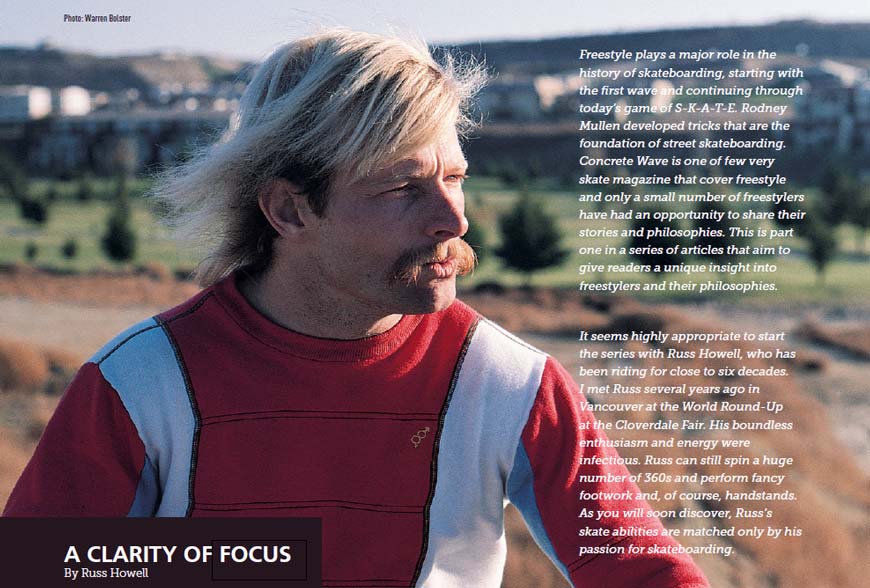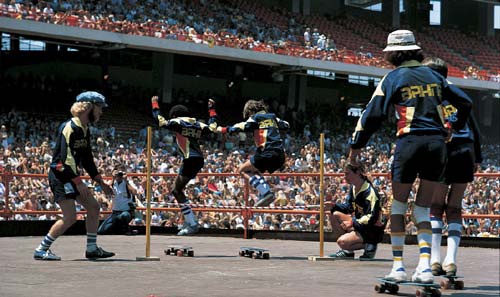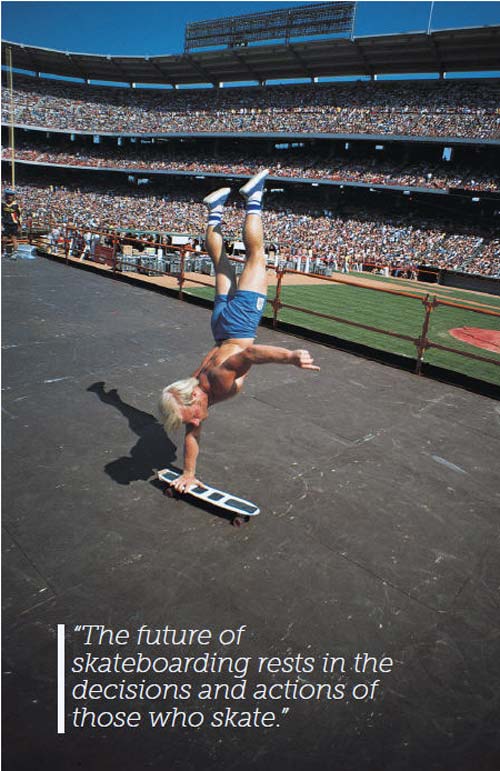
 Rolling through life on a skateboard for 58 years has changed my life. What began as an activity shared with childhood friends has evolved into a personal philosophy dedicated to serving the sport. My decisions and actions have always been a reflection of my beliefs. Consider the following two questions; although they sound similar, they are completely different.
Rolling through life on a skateboard for 58 years has changed my life. What began as an activity shared with childhood friends has evolved into a personal philosophy dedicated to serving the sport. My decisions and actions have always been a reflection of my beliefs. Consider the following two questions; although they sound similar, they are completely different.
1. Do you love to skateboard?
2. Do you love skateboarding?
The first question asks, “Do you like what skateboarding does for you and how it makes you feel?”
The second question asks, “What are you willing to do for skateboarding?”
Are we involved with skateboarding based only upon selfish motivations, or are we willing to serve the needs of the sport and its participants? My parents never had to tell me their thoughts; they lived their lives according to what they believed to be right. They gave me consistent testimony to the importance of life through their daily examples. They taught me that relationships are the most important priority any of us can have. My parents always encouraged my brothers and me to embrace the three characteristics of life: “being a child”; “being an adult”; and “being a parent.” A child enjoys play, an adult helps others, and a parent gives of himself or herself for another person’s growth. Too many have forgotten their inner child and forgotten the simple rewards of play. My ability to enjoy good health is directly related to the sports I have been involved with.
 Surfing and skateboarding are enjoyable activities that promote lifelong habits that are directly related to lifelong health. I first stepped onto a skateboard in 1958. It was a home-made 2” x 4” board with metal roller skate wheels. Our family was very poor, and I learned how to make my own skateboards and surfboards. We rode skateboards when we weren’t surfing, and skateboarding was given the nicknames of “surfing’s little brother” and “sidewalk surfing.” Surfing was my main passion in the 1960s, and I moved to a small apartment in Hawaii with a dozen other surfers in 1968.
Surfing and skateboarding are enjoyable activities that promote lifelong habits that are directly related to lifelong health. I first stepped onto a skateboard in 1958. It was a home-made 2” x 4” board with metal roller skate wheels. Our family was very poor, and I learned how to make my own skateboards and surfboards. We rode skateboards when we weren’t surfing, and skateboarding was given the nicknames of “surfing’s little brother” and “sidewalk surfing.” Surfing was my main passion in the 1960s, and I moved to a small apartment in Hawaii with a dozen other surfers in 1968.
The Vietnam War prompted my enlistment into the Air Force in 1969. I returned to college after serving in the military and graduated with a mathematics degree. A summer job of working with a YMCA camp derailed my life, and I went back to college and graduated with a degree in physical education, a teaching credential and a master’s degree in computer education. One of my assignments as a physical education student was to develop a sports-related class to benefit the community.
I taught a skateboarding class in 1974–1975 at the same public park where I had first stepped onto a skateboard in 1958 – Bixby Park in Long Beach. The urethane wheel was just being introduced into skateboarding and was making skating tremendously popular. So the park director was eager to have a skateboard safety class, and the students were quick to learn. One day a group of the kids in my skate class came up to me with a poster advertising the Del Mar Ocean Festival, which was about to host the Bahne/Cadillac National Skateboard Championships on April 26–27, 1975. I wasn’t interested in competing, but one of the kids from my skate class wanted to attend. We drove down to Del Mar that weekend and were greeted by 500 skaters who had come from all over the nation. Most of the skaters were young and had only been skating a short time. The Senior Men’s division was packed with skaters who had many years of experience, such as Skitch Hitchcock, Bob Mohr and Bruce Logan. Most of them skated with a surf style at the beach, as did I, but Del Mar focused on the same events as the 1965 Anaheim Nationals: freestyle and slalom.
 You had to skate according to the rules of the contest if you wanted to win, and our surf/skate styles were not what the judges were looking for that weekend. Although I hadn’t planned to skate in the contest, the mood of competition soon took over, and I entered the arena with visions of what it would be like to compete and do well at the Nationals. My visions paled to the comparison of the reality of what happened: I won the Senior Men’s freestyle event. As I drove home in a trance, I realized the world had just been turned upside down and my life would be changed forever.
You had to skate according to the rules of the contest if you wanted to win, and our surf/skate styles were not what the judges were looking for that weekend. Although I hadn’t planned to skate in the contest, the mood of competition soon took over, and I entered the arena with visions of what it would be like to compete and do well at the Nationals. My visions paled to the comparison of the reality of what happened: I won the Senior Men’s freestyle event. As I drove home in a trance, I realized the world had just been turned upside down and my life would be changed forever.
Winning the Nationals elevated my confidence to believe that I could finally be a voice for the sport I had loved for so many years. I’d always felt nervous about speaking confidently in front of a crowd, but that had to give way to the needs of the sport. Luckily, a speech teacher had once told me you only need two things to be an effective speaker: Know more about your subject than the audience does, and love what you’re talking about. Winning a skate event was never about being better than other skaters; it was about gaining the opportunity to become a voice to elevate, encourage and inspire others to skate. Winning the Del Mar Nationals gave me the opportunity to speak on behalf of the sport.
 Until the introduction of the urethane wheel in 1973–74, skateboarding had been dormant for nearly a decade, largely due to negative publicity. For example, the cover of the May 14, 1965 issue of Life magazine (which was hugely influential at the time), read “The Craze and the Menace of Skateboards,” and its multi-page article featured headlines like “It’s easier to get bloody than fancy.” I sought to erase the stigma of skateboarding as “a dangerous activity” and instead show it as a healthy alternative to traditional sports. Appearances on “The Tonight Show,” “Good Morning America,” “To Tell the Truth,” “Tomorrow with Tom Snyder” and countless other television shows, along with commercials and personal appearances, helped popularize skateboarding.
Until the introduction of the urethane wheel in 1973–74, skateboarding had been dormant for nearly a decade, largely due to negative publicity. For example, the cover of the May 14, 1965 issue of Life magazine (which was hugely influential at the time), read “The Craze and the Menace of Skateboards,” and its multi-page article featured headlines like “It’s easier to get bloody than fancy.” I sought to erase the stigma of skateboarding as “a dangerous activity” and instead show it as a healthy alternative to traditional sports. Appearances on “The Tonight Show,” “Good Morning America,” “To Tell the Truth,” “Tomorrow with Tom Snyder” and countless other television shows, along with commercials and personal appearances, helped popularize skateboarding.
A six-month tour to Australia resulted in opening a public concrete snake run in a town called Albany in February 1976. (That run survives and is still skated to this day – the world’s oldest existing skatepark.) Stories of how several young high school students worked with the Albany city council to build the snake run spread worldwide, and the concept of skateparks was born.
My return to America after touring Australia for six months came at the beginning of the USA competitive season. California Free Former was planning a huge World Skateboarding Championship at the Long Beach Arena. To promote the contest, Don E. Branker arranged skate demos at summer concerts for popular music acts such as Peter Frampton, Jethro Tull, Foghat and Santana. The first demo was at Anaheim Stadium during a Beach Boys concert with 55,000 spectators. A raised stage was built in the center of the stadium, and many top skaters were asked to perform.
Before the show, a group of the younger skaters came over to me and told me I had been out of the country too long and my skating career was over. They went on to tell me that they were going to take over and become the new stars of the sport. I didn’t comment, but just went back to practicing. The skate show began and I was the last one to skate. The quiet response of the crowd changed as the energy of 55,000 screaming people gave me a standing ovation. Afterward, the same group of skaters that had confronted me before the demo came up and asked to join my team. It was as if America welcomed me home again. That crowd’s reaction gave me clarity on my focus of serving the sport of skateboarding, and I would never again allow other skaters to distract me by questioning my purpose within the sport again. The popularity of skateboarding grew, and with it came the opportunity to make huge profits from related products.
 Division within the sport soon emerged, and
Division within the sport soon emerged, and  people (skaters and manufacturers) had a choice of serving the sport or their own greed for fame and fortune. Skateboard competitions were frequently corrupted by skateboard companies wanting their riders to win so they could gain advertising leverage to increase product sales. The editor of a major skate magazine threatened to blacklist me and others from appearing in his magazine if we ever appeared in any of the other skate magazines. A meeting with several skateboard manufacturers was held and decisions on how to promote the sport were discussed. I suggested that we had a responsibility to promote skateboarding in a way that would be acceptable to parents, city officials and potential corporate sponsors. Many industry representatives rejected my recommendations and went for short-term profits by catering their advertising to rebellious youth. Skateboarding lost the support of city councils, and signs banning skateboarding went up everywhere.
people (skaters and manufacturers) had a choice of serving the sport or their own greed for fame and fortune. Skateboard competitions were frequently corrupted by skateboard companies wanting their riders to win so they could gain advertising leverage to increase product sales. The editor of a major skate magazine threatened to blacklist me and others from appearing in his magazine if we ever appeared in any of the other skate magazines. A meeting with several skateboard manufacturers was held and decisions on how to promote the sport were discussed. I suggested that we had a responsibility to promote skateboarding in a way that would be acceptable to parents, city officials and potential corporate sponsors. Many industry representatives rejected my recommendations and went for short-term profits by catering their advertising to rebellious youth. Skateboarding lost the support of city councils, and signs banning skateboarding went up everywhere.
In its early days, skateboarding became popular as an alternative activity to surfing by offering an array of various expressive forms: freestyle, slalom, downhill, pool riding, streetstyle and more. It fell dormant for nearly a decade beginning in 1966 due to safety concerns. The urethane wheel helped diminish the safety concerns, but the sport went dormant again in the early 1980s due to its alignment with being a socially rebellious activity. Skateparks have been established all over the world, and yet we now face another possible decline within the industry. Why are these companies surprised at low product sales when they have not embraced the full dimension of the sport? Broadening the demographic to which you market any product will increase sales.
I believe a collective unity among the various forms of skateboarding would have produced greater appeal and a stronger foundation for the expansion and benefit of the sport. Computer pioneer Alan Kay famously said, “The best way to predict the future is to invent it.” The future of skateboarding rests in the decisions and actions of those who skate. It remains my hope that more riders will embrace the calling to serve the sport and everyone within it.
Thanks to Michael Brooke of Concrete Wave Magazine!
Russ Howell showing us how it’s done. 97 360’s!
